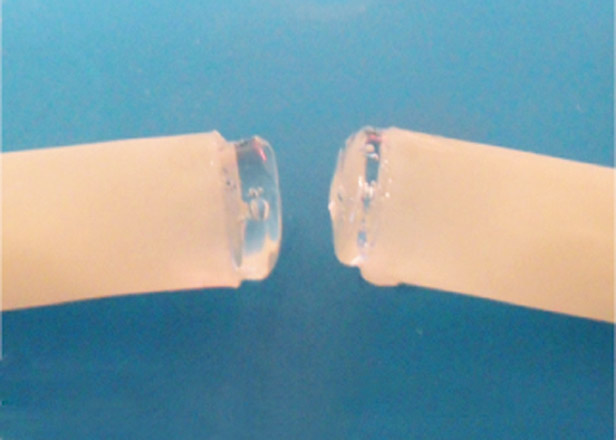Gluing Blood Vessels

Source: “Vascular anastomosis using controlled phase transitions in poloxamer gels”
Geoffrey C. Gurtner et al.
Nature Medicine 17: 1147–1152
Results: Researchers developed a heat-sensitive polymer that allows surgeons to prop open a severed blood vessel so they can glue its ends together, avoiding the need for sutures. In tests in rats, the procedure worked in vessels smaller than half a millimeter in diameter, where traditional sutures failed. The technique was also faster than sewing and resulted in less scarring and inflammation.
Why it matters: The gel could aid in delicate surgeries and make it easier to repair blood vessels that are small or difficult to access, particularly is infants. It may also prove useful for minimally invasive surgeries, in which surgeons have little room to maneuver and suturing is particularly difficult.
Methods: The researchers altered the chemical properties of a medically approved polymer so that it is liquid at body temperature but solidifies at a few degrees higher. They heated the area around severed vessels in rats and used the solid polymer to hold the ends open. The open ends were then reconnected with surgical glue. When the area cooled back to body temperature, the polymer melted and dissolved into the bloodstream.
Next Steps: The researchers are trying to improve the glue used to seal the two ends of the blood vessel. They aim to test the technology in patients next year.
Reversing Aging in the Brain
Young blood stimulates cell growth in old mice
Source: “The ageing systemic milieu negatively regulates neurogenesis and cognitive function”
Tony Wyss-Coray et al.
Nature 477: 90–94
Results: Blood from young mice can relieve inflammation in the brains of old mice while improving memory, promoting increased neural activity, and stimulating the growth of new brain cells. Blood from old mice has the reverse effect on the brains of younger mice. Researchers linked the brain aging effect to a specific chemical in blood that increases with age and has previously been associated with allergies and asthma.
Why it matters: The findings suggest that brain aging is in part caused by molecules in the blood and not by a process intrinsic to brain cells themselves. They also suggest the possibility of slowing age-related decline by blocking the chemical. In addition, monitoring the blood for chemicals linked to brain aging might be useful in assessing brain health, since brain tissue is difficult to test directly.
Methods: The researchers surgically linked two mice—one of them old and one young—so that they shared a circulatory system. They monitored the animals’ brains and screened 60 molecules found in blood to identify those that affect the brain.
Next Steps: The researchers continue to search for blood-borne factors that influence brain aging.
Keep Reading
Most Popular
Large language models can do jaw-dropping things. But nobody knows exactly why.
And that's a problem. Figuring it out is one of the biggest scientific puzzles of our time and a crucial step towards controlling more powerful future models.
The problem with plug-in hybrids? Their drivers.
Plug-in hybrids are often sold as a transition to EVs, but new data from Europe shows we’re still underestimating the emissions they produce.
Google DeepMind’s new generative model makes Super Mario–like games from scratch
Genie learns how to control games by watching hours and hours of video. It could help train next-gen robots too.
How scientists traced a mysterious covid case back to six toilets
When wastewater surveillance turns into a hunt for a single infected individual, the ethics get tricky.
Stay connected
Get the latest updates from
MIT Technology Review
Discover special offers, top stories, upcoming events, and more.